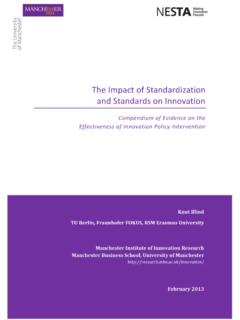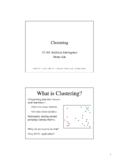Transcription of Cluster Policy: A Review of the Evidence
1 1 Manchester Institute of Innovation Research Cluster policy : A Review of the Evidence Compendium of Evidence on the Effectiveness of Innovation policy Intervention T h is repo rt i s a p ar t o f t h e C o mpendium o f Evidenc e o n t h e Ef f ec t ivene ss o f Inno v at io n Po l ic y Int erve nt io n pro jec t f un ded by t h e N at io nal Endo wment f o r Sc ienc e , T ec h no l o gy an d t h e A rt s (N EST A ). Elvira Uyarra and Ronnie Ramlogan Manchester Institute of Innovation Research Manchester Business School, University of Manchester March 2012 Cluster policy : A Review of the Evidence Uyarra and Ramlogan 2 Manchester Institute of Innovation Research Table of Contents List of Tables.
2 2 Executive summary .. 1 1 Introduction .. 2 2 Conceptual Background .. 2 What are Clusters? .. 2 The economic importance of clusters .. 3 Cluster policy in perspective .. 5 Cluster policy evaluation .. 13 3 Specific analysis of selected Cluster initiatives .. 15 Scope and characteristics of selected Cluster programmes .. 15 Key findings from the case study Cluster evaluations .. 22 4 32 Acknowledgements .. 35 References .. 35 Appendix .. 43 List of Tables Table 1. Instruments promoting clusters .. 11 Table 2. Characterisation of Cluster policies .. 12 Table 3. Selected Cluster programmes .. 17 Table 4. Main Evidence .. 20 Table 5. policy Evaluation Studies .. 43 Cluster policy : A Review of the Evidence Uyarra and Ramlogan 1 Manchester Institute of Innovation Research Executive summary In recent years clusters have become an important component of the policymaker s toolbox particularly in respect to endogenous pressures for growth and innovation.
3 Academic and policy interest in clusters have emerged from the observation that many industries tend to Cluster and the ex-post analyses of the economic and innovation performance of a number of high profile clusters. However, despite the popularity of the Cluster concept and the widespread use of Cluster policy , the question of whether public support of clusters is effective, particularly for innovation, is an open one. Many studies in the literature have focussed on the characteristics of industrial clusters, Cluster performance or on how to best support Cluster development, but they stop short of the trying to understand the extent to which Cluster policy is delivering tangible economic impacts.
4 This report seeks to address this Evidence gap. It first reviews the main arguments underpinning Cluster policy . It subsequently focuses on a number of recent experiences in supporting clusters across the OECD, and further highlights the challenges associated with the evaluation of these initiatives and available Evidence on their outcomes. It then focuses on the Evidence of a number of programmes (16) that are selected for closer scrutiny. The report draws on available Cluster policy evaluation exercises and related academic literature to report on the impacts and outcomes, both soft and substantive, of Cluster policy .
5 Illustrative of the diversity of Cluster policy , the policies under consideration differ considerably in rationales, objectives and operationalisation. Similarly, the evaluations of the programmes selected differ in terms of their timing, objectives and methodologies used. Nevertheless a number of consistent threads and key observations emerge across the evaluation reports: a) There is a general finding that Cluster policies provide the resources and framework to advance the innovation potential of different interest groups. b) In terms of the governance, early private sector involvement is important to secure market oriented strategies in the targeted clusters.
6 C) Clusters require dedicated management teams with a blend of skills and competencies to reconcile the interest of the private and public sector participants. d) The provision of support services within clusters is an important element for generating long-terms benefits for Cluster participants. e) Public sector Cluster investments have been successful in leveraging private funding but this seems to be contingent on the nature of the Cluster . High technology clusters appear to be better placed than more traditional industry clusters in attracting private sector funding. f) There is no clear and unambiguous Evidence that over the long term clusters are able to generate strong and sustainable impacts in terms of innovation, productivity or employment Finally, some broad implications for policy are drawn, in particular in relation to the need for policies to improve their clarity and focus in their choice of objectives and rationales, the need to allow for evaluation early on in the process, the use of flexible and adapted interventions that are realistic rather than a rigid Cluster model.
7 Together with a more careful targeting and a better balance between a hands-off approach and direct steering of clusters. Cluster policy : A Review of the Evidence Uyarra and Ramlogan 2 Manchester Institute of Innovation Research 1 Introduction In recent years, clusters have become an object of interest for academics and policy makers alike. Attention to clusters has been stimulated by the emergence of high-profile clusters such as Silicon Valley or industrial districts in Italy. policy makers both in developed and developing countries have sought similar developments through implementing Cluster programmes. Despite the popularity of the term Cluster and the widespread use of Cluster policy , the nature of Cluster policies and particularly their impacts are less well understood.
8 Nauwelaers and Wintjes (2008) highlight the gap that exists between the notable diffusion of the Cluster model and the little progress made with regard to learning in Cluster policy making and Cluster policy learning. Indeed, many studies within the literature focus on the characteristics of industrial clusters, Cluster performance or on how to best support Cluster development, but stop short of addressing the actual implementation of Cluster policy . The benefits of clusters referred to in the literature relate to studies that examine the effects of clustering when it occurs naturally , rather than constituting a direct assessment of Cluster initiatives (Duranton, 2011).
9 Particularly overlooked aspects relate to Cluster policy implementation (Sternberg et al., 2010), governance processes and their influence on the evolution and performance of clusters (Borr s and Tsagdis, 2008), and the evaluation of the impacts of Cluster support (Raines, 2003; Fromhold-Eisebith and Eisebith, 2005; Schmiedeberg, 2010). This report seeks to address this Evidence gap first by reviewing the main arguments underpinning Cluster policy . Section two of the report then focuses on recent policy experiences in supporting clustering in a number of OECD countries, highlighting their main characteristics and differences. It further highlights the challenges associated with the evaluation of these initiatives, in particular the diversity in rationales, instruments and implementation forms, and the systemic and indirect nature of the intervention.
10 Section three then focuses on available Evidence on the outcome of Cluster policy . In particular, the report examines 16 evaluations of regional and national Cluster policies, all in developed countries. It draws on available Cluster policy evaluation exercises and related academic literature in order to report on the impacts, both soft and substantive, of the selected Cluster programmes. We conclude by drawing some general lessons and implications. 2 Conceptual Background What are Clusters? The concept of clusters can be related to various conceptual and theoretical developments around locally embedded groups of firms and other organisations, such as industrial districts , new industrial spaces and flexible specialisation , regional innovation systems (see, for instance Pyke et al, 1990; Brusco, 1982; Scott, 1986; Piore and Sabel, 1984, Cooke et al, 1997).



